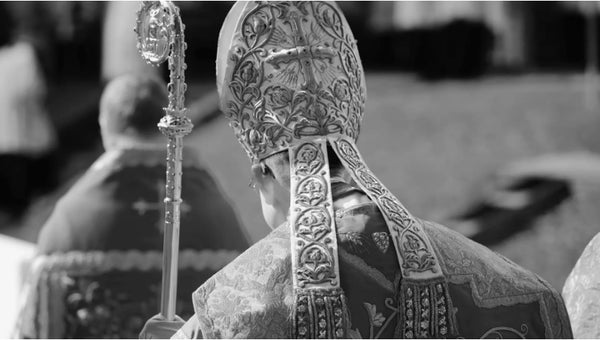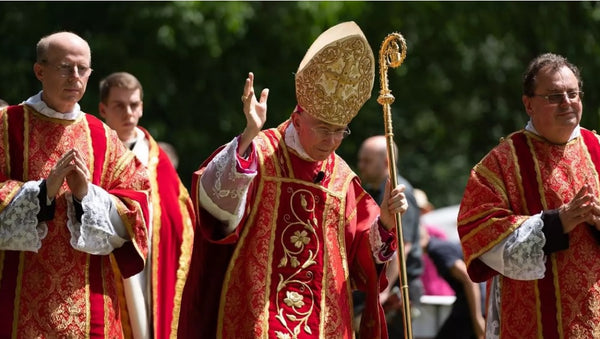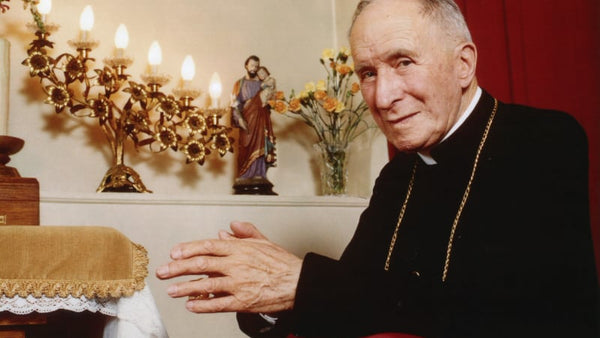SSPX Ordinations 2018 - 7 New Priests Ordained in Virginia
St. Thomas Aquinas Seminary saw 6 men from the United States and 1 from Ireland raised to the Eternal Priesthood of Our Lord Jesus Christ.
For the last seven years, 2011-2018, the priestly candidates of St. Thomas Aquinas Seminary have meticulously prepared for their priestly ordination through study, prayer, and the discipline of a rigorous seminary formation. These seven deacons were ordained to the Eternal Priesthood on Friday, June 22nd, 2018, by Bishop Bernard Tissier de Mallerais at the Seminary in Dillwyn, Virginia.
As hundreds of faithful watched, Bishop Tissier called each Deacon by name, marking the sacred moment the Church officially recognizes the priestly vocation of each candidate. The candidates each answered the call of the bishop thus fulfilling the priestly intent of the last seven years. The candidates then, lying prostrate on the ground, called upon the saints in heaven to help them in that most solemn time.
Following this invocation, the Bishop then loosened their chasubles to show that the Church visibly permits Her new priests to absolve sins through the sacrament of Confession. The Bishop lastly placed his hands on the head of each ordinand, in sign of approval of the candidate, as did every priest present, with likewise approval.
Each received the Holy Oil upon their hands in the act of consecrating themselves entirely to their new apostolic mission of saving souls for Christ, as an 'Alter Christus'. The newly ordained priests offered their first Mass in unison with the Bishop and with the help of an assistant priest.
Six new priests from the United States and one from Ireland were ordained: Fr. Thomas Buschmann, Fr. Samuel Fabula, Fr. John Graziano, Fr. Michael Sheahan, Fr. Thomas Tamm, Fr. Nicolas McManus, and Fr. Thomas O’Hart.
Following this event, Bishop Bernard Fellay will ordain three priests on Friday, June 29th in Econe, Switzerland. The next day, Bishop Alfonso de Galarreta will confer the Holy Priesthood on six more candidates in Zaitzkofen, Germany – totaling sixteen new priests for the Priestly Society of St. Pius X. These ordinations mark the continued growth of the Society (towards) preserving the Catholic priesthood and drawing down God’s grace to souls through the sacraments and the Mass.

Also in News from Tradition

Death of Bishop Bernard Tissier de Mallerais

Prayer Intention for Bishop Tissier de Mallerais
We ask for prayers for His Excellency Bishop Tissier de Mallerais.
On the morning of Saturday 28 September, after the Angelus, he fell on the stairs of the seminary in Ecône and lost consciousness. He is currently in hospital.

Archbishop Marcel Lefebvre on the Feast of Christ the King
The following sermon for the Feast of Christ the King was delivered by Archbishop Marcel Lefebvre, founder of the Society of Saint Pius X (SSPX), on October 29, 1989 in Dublin, Ireland.
Today we must pray to Our Lord Jesus Christ, we must pray to the Blessed Virgin Mary to remain true Catholics and to do everything possible to become saints. We must come to church frequently, pray in our church, receive the graces of the sacraments in order to become saints, to sanctify our souls and to go to heaven with all the members of our families and all those who kept the Catholic Faith here on earth and now enjoy the happiness of heaven.

Angelus Press
Author